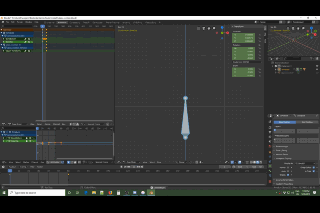I finally resolved a problem that has plagued me for years, which is simulating liquid filling in a cocktail glass. It seems like this could be solved with a simple scale in the upward direction in Unity, but it’s a lot more complex. My cocktail glass model has two meshes, one for the glass which remains static and another for the fluid which increases in size as the glass is filled. The fluid mesh is an upsidedown cone with a flattened top. Simply scaling the fluid mesh will result in the fluid mesh not correctly filling the glass.

When I created the original fluid mesh in Blender , I believe I used the boolean difference modifier, but it’s been years since I created it so I could have possibly used some other method. For the animation, I used an armature in Blender with two bones. A bottom bone for controlling the ring of vertexes at the bottom of the fluid mesh and a top bone for controlling the ring of vertexes at the top of the mesh.
The new 2.80 version of Blender has significant changes for weight painting. I created the following infographic to show the process I use for weight painting a mesh. For my fuild mesh, I set full wieght of the top vertexes to the top bone, and the full weight of the bottom vertexes to the bottom bone.
To solve the liquid filling problem, the bottom set of vertexes must remain unchanged, while the top vertexes move upward and scale outward. The fluid mesh is modeled with the glass filled. Therefore, in Blender the default pose is the last frame in the animation. I used 60 frames for this animation, so I set the keyframe for the 60th frame with the default pose. It is important to set the keying mode to location, rotation, and scale. In most of my games, I only set the key mode to location and rotation, since game objects are rarely ever scaled.
To create the filling effect, in Animation mode I set the frame in the timeline to the first frame. Then I select the top bone and scale it inward (on the X and Y axes) so that it matches the same diameter as the bottom of the glass (and same diameter as the ring of bottom vertexes). Then I translate the top bone downward, until it exactly overlaps with the bottom ring of vertexes. Then I add a keyframe for the first frame. Pressing play will show the simulated liquid starting from the bottom of the glass and filling to the rim of the glass.

I plan to use this new liquid fill animation technique to update Bartender Game in the near future.

